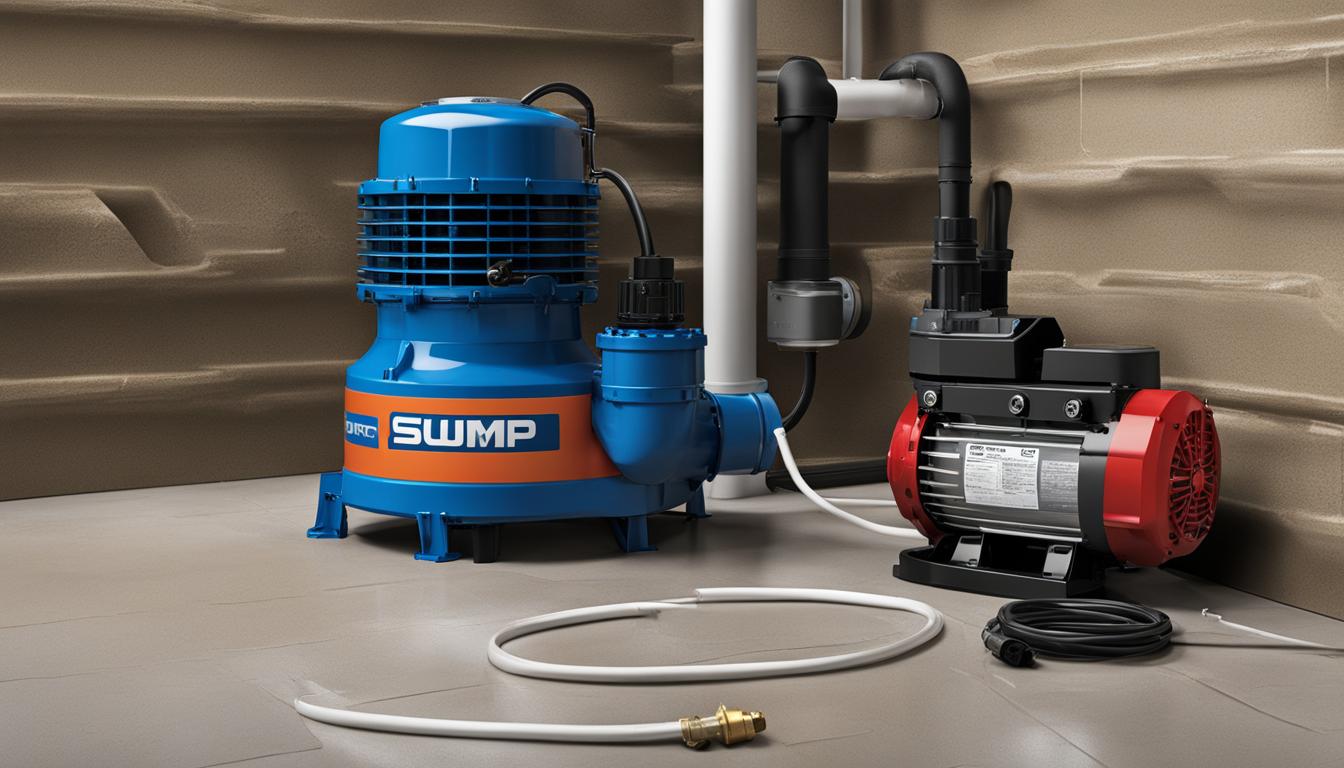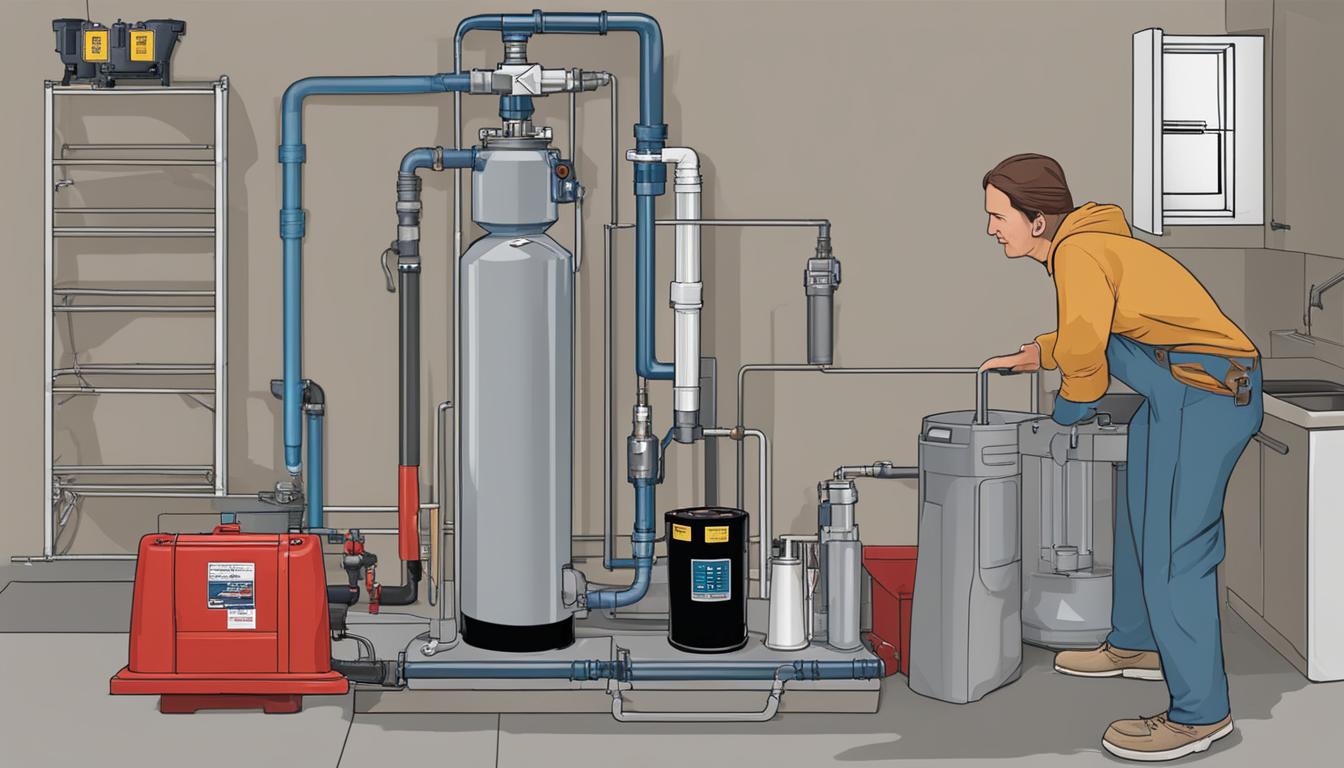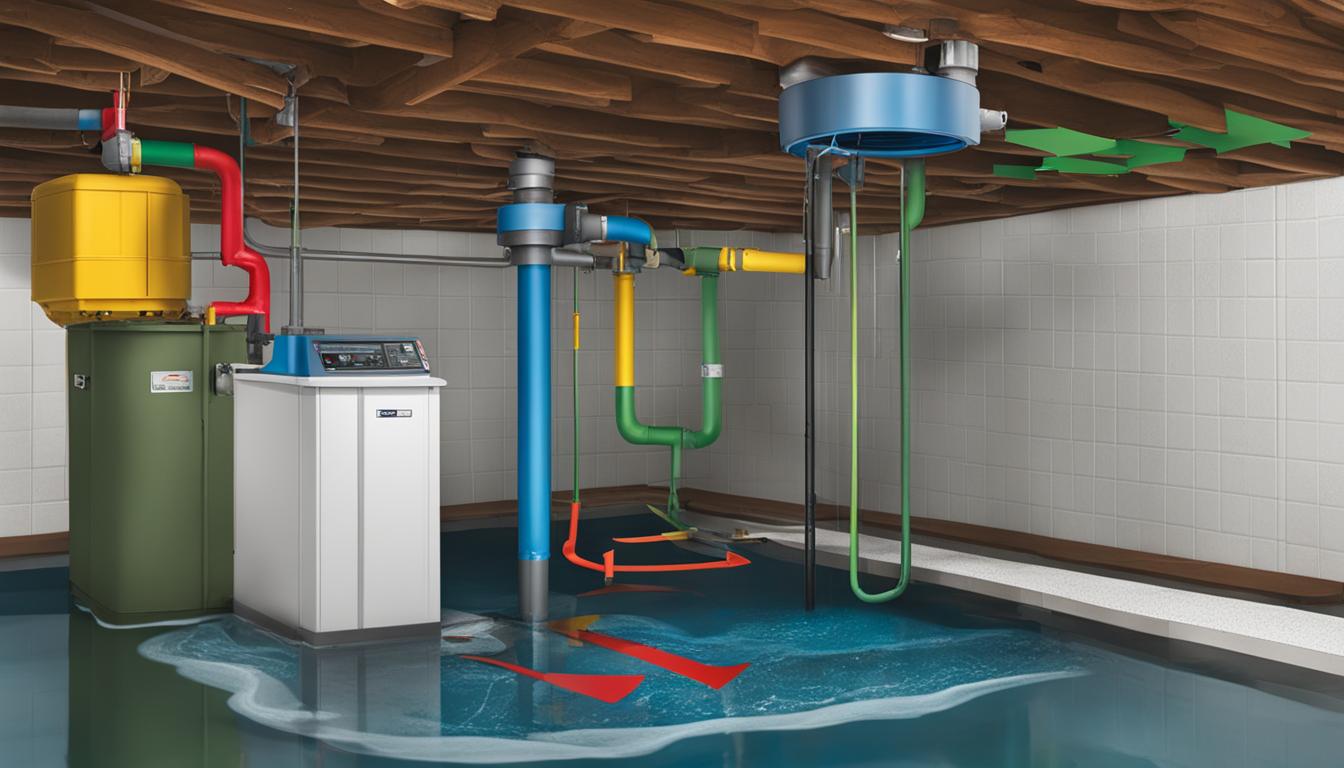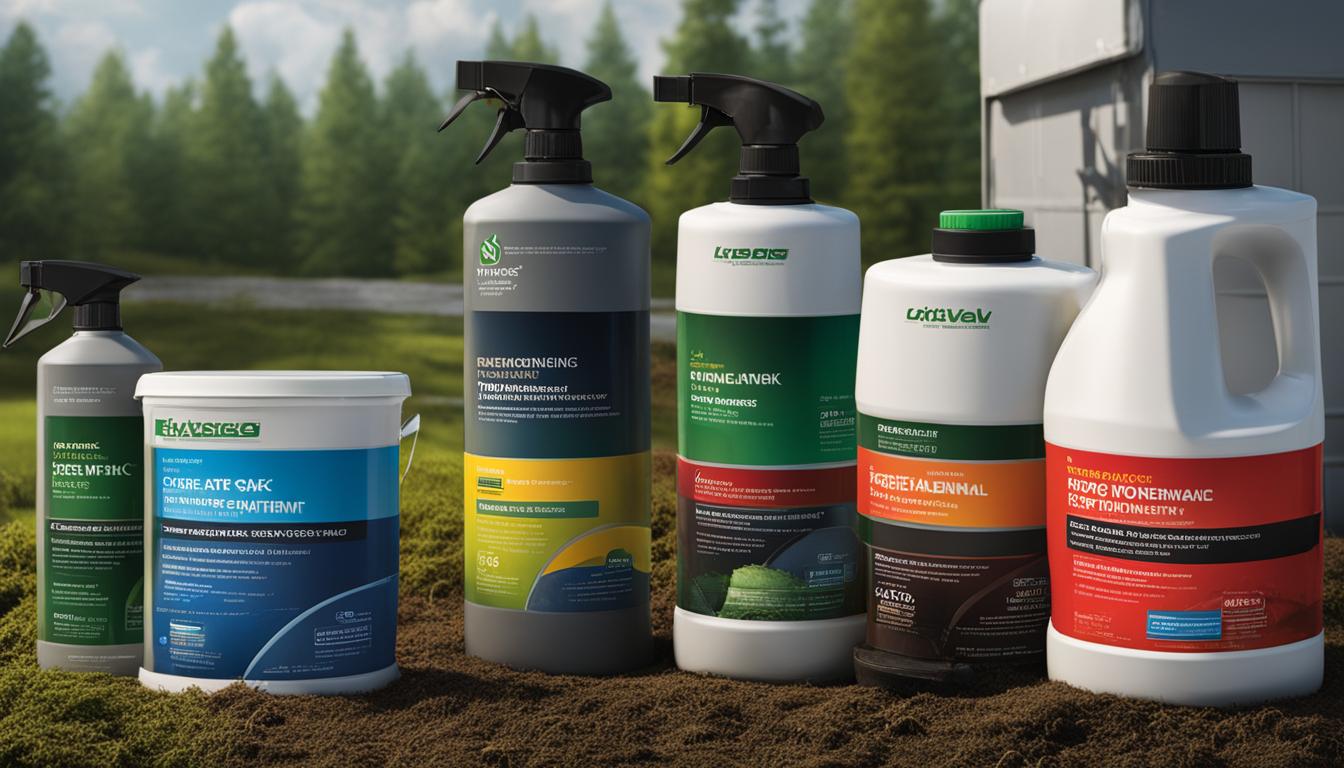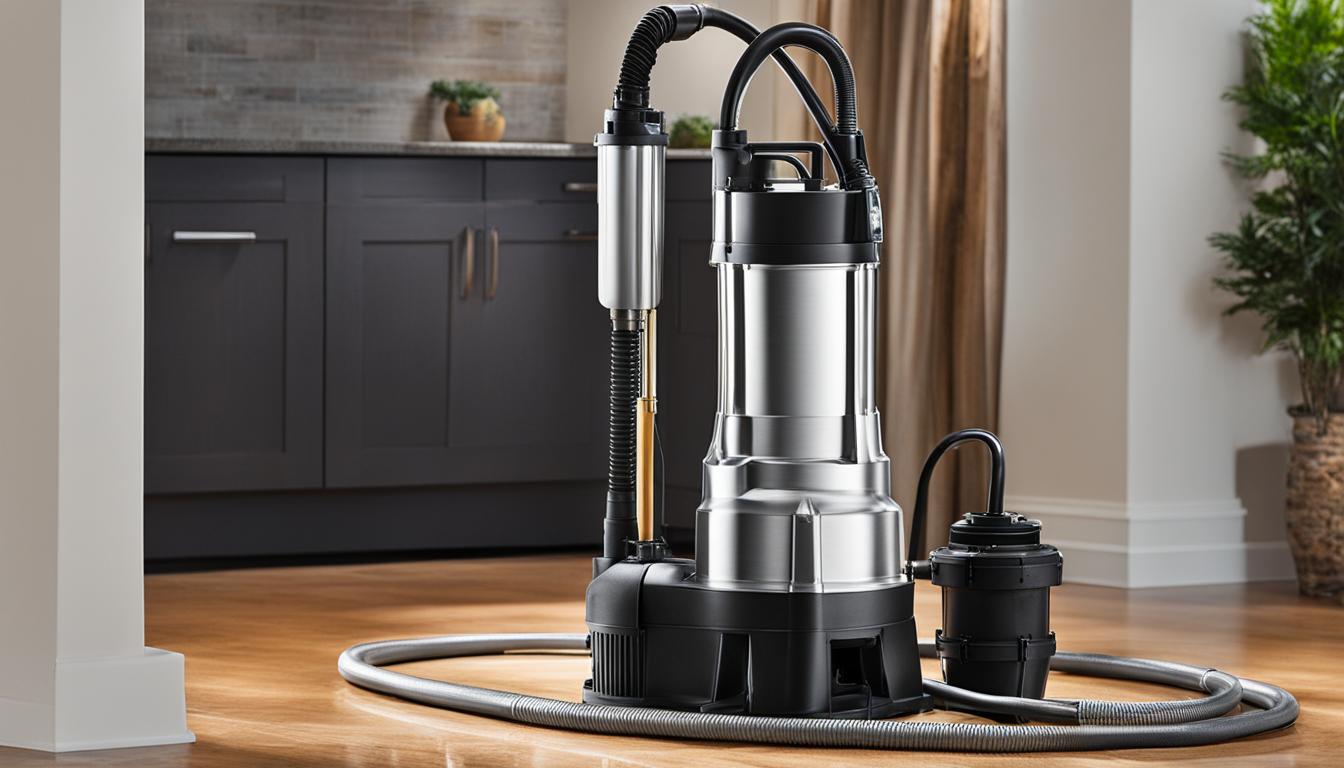Are you looking for the best solution to prevent flooding in your home? Look no further than single stage sump pumps. These pumps are designed to effectively handle water accumulation and help protect your property from water damage. In this comprehensive guide, we will provide a detailed comparison of single stage sump pumps, including their features, efficiency, and performance analysis, helping you find the perfect flooding solution for your needs.
Key Takeaways
- Single stage sump pumps are an effective solution for preventing water damage in your home.
- Comparing the features, efficiency, and performance of different pumps can help you find the best one for your needs.
- Choosing the right capacity and understanding cost implications can help you make an informed decision when selecting a pump.
- Single stage sump pumps can be used in various scenarios and environments to effectively manage and prevent flooding.
- Understanding the differences between single stage and multi-stage sump pumps can help you make an informed decision and choose the best option for your home.
Understanding Single Stage Pumps
At the heart of any single stage sump pump is a centrifugal pump, which utilizes impellers to propel water through the discharge pipe and out of the sump pit. Single stage sump pumps are designed to remove water quickly and efficiently, making them an ideal choice for most residential and commercial applications.
An important factor to consider when selecting a single stage pump is its efficiency. Efficiency is critical because it directly affects the performance of the pump and its ability to handle flooding situations. The efficiency of a pump is determined by its flow rate and head pressure, which are measures of the volume of water it can move and the height it can push it through the discharge pipe.
Performance analysis is an essential aspect of selecting the right single stage pump. It involves testing the pump under various conditions, such as varying flow rates and head pressures, to determine its optimal operating range. The results of the performance analysis can help you choose a pump that will provide the best performance and efficiency for your specific needs.
Benefits of Single Stage Sump Pumps
Single stage sump pumps provide efficient and effective solutions for preventing water damage. Here are some of the advantages of using a single stage sump pump to manage flooded areas:
- Reliable performance: A single stage sump pump offers reliable performance and efficient water removal capabilities, ensuring your basement or crawlspace remains dry and safe.
- Easy installation: Single stage sump pumps are easy to install and maintain, making them a popular choice among homeowners and contractors alike. The installation process is straightforward, and the pump can be operational within hours.
- Cost-effective: Single stage sump pumps are an affordable flooding solution, making them accessible to homeowners and small businesses alike. Though they may not have as many features as their multi-stage counterparts, they provide efficient and cost-effective services for managing flooded areas.
- Compact design: Single stage sump pumps have a compact design that makes them easy to store, transport, and install in tight spaces. This feature is especially important for homeowners with limited space in their basement or crawlspace.
- Energy efficient: Single stage sump pumps consume less energy than multi-stage pumps, making them a cost-effective solution for homeowners concerned about their energy bills. They also offer excellent water removal capabilities, ensuring that your basement or crawlspace remains dry and safe.
Overall, single stage sump pumps provide efficient and cost-effective solutions for preventing water damage in your home or business. They are easy to install, reliable, and energy-efficient, making them an ideal choice for homeowners looking for effective flooding solutions.
Factors to Consider When Choosing a Single Stage Sump Pump
When selecting a single stage sump pump, there are several important factors to consider. These factors will help you make an informed decision and ensure that you choose a sump pump that meets your specific needs.
Capacity Planning
One of the most crucial factors in selecting a single stage sump pump is determining the appropriate capacity. The capacity of a sump pump is measured in gallons per minute (GPM) and will depend on several factors, including the size and depth of your basement or crawl space, the amount of rainfall in your area, and the frequency of flooding.
It is vital to choose a sump pump with a capacity that can handle the maximum amount of water expected during heavy rainfalls or unexpected flooding. If the pump is too small for your needs, it may not be able to keep up with the incoming water, leaving your home vulnerable to water damage.
Power Source
Single stage sump pumps can be powered by either electricity or batteries. Electric-powered sump pumps are reliable and consistent, but they do require an electrical outlet nearby, which may not be possible in all areas. Battery-powered sump pumps are ideal for areas with frequent power outages or where electricity is not readily available. However, these pumps require periodic battery replacements and may not be as powerful as electric pumps.
Build Quality
The build quality of a sump pump is essential for ensuring its durability and longevity. Look for models with sturdy materials such as cast iron or thermoplastic, which can withstand heavy use and resist corrosion. Additionally, pumps with a sturdy base and non-clogging impeller can ensure that the pump operates efficiently.
Brand Reputation and Warranty
When it comes to choosing a sump pump, it’s important to consider the reputation of the brand and the warranty offered with the product. Brands with an established reputation for quality and reliability may be more expensive, but often come with longer warranties and better customer service. A warranty can provide peace of mind that your investment is protected in case of a defect or malfunction.
Installation and Maintenance
Finally, it’s essential to consider the installation and maintenance process for your chosen sump pump. Some models may require professional installation, while others can be installed by the homeowner. Additionally, regular maintenance, such as cleaning and testing the pump, is crucial for ensuring that it remains in good working order. Look for models that are easy to install and maintain to save time and money in the long run.
Top Picks for Single Stage Sump Pumps
After thorough research and analysis, we have selected our top picks for the best single stage sump pumps on the market. These pumps have been chosen based on their features, performance, and overall value. We believe they offer the most effective flooding solutions to protect your home.
| Product | Features | Pros | Cons |
|---|---|---|---|
| Superior Pump 91250 1/4 HP Thermoplastic Utility Pump | – 1-1/4-inch NPT discharge – Durable, corrosion-resistant thermoplastic construction – 10-foot cord length – Compact design for easy portability |
– Affordable price point – Excellent for small to medium-sized sump pits – Can handle high water volume – Energy-efficient motor |
– Not suitable for heavy-duty or commercial use – May struggle with debris or solid waste – Short lifespan compared to higher-end models |
| WAYNE CDU980E 3/4 HP Submersible Cast Iron and Stainless Steel Sump Pump | – Stainless steel and cast iron construction for durability – 3/4 HP motor – Top suction design filters debris and minimizes clogging – Vertical float switch for automatic operation |
– High-quality materials and construction – Can handle heavy-duty use – Powerful motor with high water flow capacity – Energy-efficient |
– Higher price point than some other models – May be too powerful for small sump pits – May require professional installation |
| Zoeller M53 Mighty-mate Submersible Sump Pump | – Durable cast iron construction – 1/3 HP motor – Automatic operation with float switch – Built-in thermal overload protection |
– Can handle heavy-duty use – Long lifespan – Energy-efficient – Easy to install and maintain |
– Higher price point than some other models – May be too powerful for small sump pits – Can be noisy during operation |
Overall, we believe these three pumps offer the best value and most efficient solutions for preventing flooding in your home. Whether you have a small or large sump pit, these pumps can handle various water volumes and provide automatic operation for easy use. Remember to consider your specific needs and capacity requirements when selecting a single stage sump pump.
Cost Implications of Single Stage Sump Pumps
When considering purchasing a single stage sump pump, it’s essential to take the cost implications into account. While the initial cost of a single stage sump pump may be lower than multi-stage sump pumps, it’s crucial to remember that the total cost of ownership may vary based on several factors.
Maintenance Costs
One essential factor to consider is the maintenance costs associated with single stage sump pumps. While maintenance costs are lower compared to other pumps, regular inspection and cleaning are necessary to ensure optimal performance. Consider investing in an extended warranty and professional maintenance services to keep your pump in excellent condition.
Long-term Savings
Single stage sump pumps are incredibly energy-efficient, operating at low wattage and voltage to save on electricity bills. They are perfect for homeowners looking for eco-friendly solutions to manage flooding. With long service life and energy savings, single stage sump pumps offer a significant return on investment in the long run.
Pricing Range
The pricing range for single stage sump pumps may vary depending on the features, performance, and capacity. However, single stage sump pumps are generally affordable and accessible to homeowners on a budget. Consider the features and capacity that meet your specific needs and budget when selecting the right single stage sump pump.
In conclusion, the cost implications of single stage sump pumps are a vital consideration for those looking to prevent flooding and protect their homes. While the initial cost may be lower, maintenance costs, long-term savings, and pricing ranges may vary. By carefully evaluating your specific needs and budget, you can select the right single stage sump pump to save money and protect your home effectively.
Usage Scenarios for Single Stage Sump Pumps
Single stage sump pumps can be used in a variety of scenarios to manage and prevent flooding. Here are some common situations where these pumps can provide effective solutions:
- Residential Basements: If you live in an area with high water tables or prone to flooding, installing a single stage sump pump in your basement can help prevent water damage and flooding. By directing excess water away from your home’s foundation, these pumps can protect your basement from water damage.
- Commercial Buildings: Many commercial buildings have basements or lower levels that can be at risk of flooding. Single stage sump pumps can be installed to provide effective flooding solutions, protecting valuable equipment and inventory from water damage.
- Outdoor Areas: Single stage sump pumps can also be used in outdoor areas prone to flooding, such as parking lots or underground garages. By effectively managing excess water, these pumps can prevent damage and maintain safe conditions for vehicles and pedestrians.
Comparison to Multi-Stage Sump Pumps
When considering the usage scenarios for single stage sump pumps, it’s important to note that they may not be suitable for all situations. In some cases, multi-stage sump pumps may be a better choice, especially in large commercial or industrial settings.
Multi-stage sump pumps typically have higher capacities and can handle larger volumes of water, making them more effective in high-volume flood situations. They may also be more durable and have longer lifespans, making them a better long-term investment in certain scenarios.
However, for most residential and smaller commercial scenarios, single stage sump pumps are a practical and cost-effective solution. They provide reliable and efficient flooding solutions, protecting your property and valuables from water damage.
Tip: When considering which sump pump to use, always consult a professional to assess your unique situation and make recommendations based on your specific needs.
Multi-Stage Sump Pumps vs Single Stage Sump Pumps
When it comes to sump pumps, you’re likely to come across two types – multi-stage and single stage sump pumps. Both are designed to prevent water damage caused by flooding, but they operate differently and have their unique advantages and disadvantages.
Comparison
Let’s start by comparing the two types of sump pumps.
| Parameter | Multi-Stage Sump Pumps | Single Stage Sump Pumps |
|---|---|---|
| Pump Efficiency | High Efficiency | Low Efficiency |
| Motor Capacity | Higher Capacity | Lower Capacity |
| Cost Implication | More Expensive | Less Expensive |
| Noise Level | Noisier | Less Noisy |
As you can see, multi-stage sump pumps are more efficient, have higher motor capacity, and are more expensive than single stage sump pumps. However, single stage sump pumps are less noisy and more affordable.
Advantages of Multi-Stage Sump Pumps
“Multi-stage sump pumps are designed to handle high volumes of water, making them ideal for larger buildings. They have high efficiency, ensuring they can work for extended periods without overheating.”
Multi-stage sump pumps are more powerful and efficient than single stage sump pumps. They’re designed to handle high volumes of water and are ideal for larger buildings that require a lot of water to be pumped out in a short period. They’re also equipped with high efficiency motors, ensuring they can work for extended periods without overheating.
Advantages of Single Stage Sump Pumps
“Single stage sump pumps are less expensive, easy to install, and less noisy than multi-stage sump pumps.”
Single stage sump pumps are less expensive than multi-stage sump pumps, making them a more affordable option for homeowners on a budget. They’re also easy to install, and their operation is less complicated than that of a multi-stage sump pump. Additionally, single stage sump pumps are less noisy, making them suitable for residential areas where noise pollution is a concern.
Which One Should You Choose?
The choice between a multi-stage and a single stage sump pump depends on your specific needs and budget. Multi-stage sump pumps are ideal for large commercial buildings, whereas single stage sump pumps are suitable for homes and small commercial buildings.
In conclusion, both multi-stage and single stage sump pumps offer effective solutions for preventing water damage caused by flooding. Consider your needs, budget, and installation requirements before making a choice between the two.
Capacity Planning for Single Stage Sump Pumps
Choosing the right capacity for your single stage sump pump is crucial in ensuring it effectively prevents flooding in your home. Here are some guidelines and considerations to help you determine the appropriate pump capacity:
- Calculate the total volume of water that needs to be pumped: This can be determined by measuring the area of your basement floor and multiplying it by the height of the water table in your area.
- Consider the pump’s flow rate: The flow rate is the amount of water that the pump can move per minute. It is usually measured in gallons per minute (GPM). To calculate the flow rate you need, divide the total volume of water that needs to be pumped by the time you want it to take.
- Consider the head pressure: The head pressure is the height that the pump will have to move the water. To determine the head pressure, measure the vertical distance between the sump pump and the highest point in your home that the water will be pumped to.
- Factor in the pump’s horsepower: Typically, the higher the horsepower, the greater the pumping capacity. However, keep in mind that a higher horsepower also means a higher cost.
Example Calculation:
If your basement is 1000 square feet, with a water table of 6 inches, the total volume of water in the basement would be 500 gallons (1000 ft² x 0.5 ft). If you want the pump to be able to remove the water within an hour, you need a flow rate of at least 8.3 GPM (500 gal ÷ 60 min).
If the height from the sump pump to the highest point in your home where the water will be pumped is 10 feet, the head pressure would be 10 feet.
Based on these calculations, you need a pump with a capacity of at least 8.3 GPM and a head pressure of 10 feet.
By considering these factors and doing proper capacity planning, you can ensure your single stage sump pump will effectively prevent flooding and protect your home.
Conclusion
We hope this comprehensive guide to single stage sump pumps has helped you make an informed decision on choosing the perfect solution for your home’s flooding needs.
Recapitulation
In this article, we provided a detailed comparison of single stage sump pumps, delved into their functionality, discussed the benefits they provide as a flooding solution, and explored different usage scenarios. We also provided a buyer’s guide and reviewed our top recommendations for single stage sump pumps.
Final Thoughts
Single stage sump pumps are a reliable and efficient solution for preventing water damage in your home. While their cost implications and capacity planning may vary, choosing the right single stage sump pump can save you significant amounts of money in the long run.
Our aim is to provide relevant information and help you make an informed decision when it comes to finding the best solution for your home’s flooding needs. We hope this guide has been helpful and insightful.
Thank you for reading.
FAQ
What is a single stage sump pump?
A single stage sump pump is a type of pump designed to remove water from basements or crawl spaces. It operates using a single impeller and motor, which allows it to efficiently pump water out of the sump pit.
How does a single stage sump pump work?
A single stage sump pump works by using an impeller to create a centrifugal force that pushes water out of the sump pit and away from the foundation of your home. When the water level rises in the pit, it triggers a float switch that activates the pump, starting the pumping process.
How efficient are single stage sump pumps?
Single stage sump pumps are known for their efficiency in quickly removing water from the sump pit. They are designed to handle moderate to heavy amounts of water and can effectively prevent flooding in basements or crawl spaces.
Are single stage sump pumps noisy?
Single stage sump pumps can produce some noise while operating, but modern models are designed to be relatively quiet. The noise level can vary depending on factors such as the pump’s motor and installation location.
How often should a single stage sump pump be maintained?
It is recommended to inspect and test your single stage sump pump at least once a year. Regular maintenance may include cleaning the pump, checking the float switch, and ensuring proper operation. Consult the manufacturer’s guidelines for specific maintenance instructions.
Can a single stage sump pump handle heavy rainfall?
Single stage sump pumps are designed to handle moderate to heavy amounts of water. However, their capacity may vary depending on the specific model and its pumping capabilities. It is important to choose a pump with the appropriate capacity for your expected water removal needs.
Are single stage sump pumps easy to install?
Single stage sump pumps can be relatively easy to install, especially if you have basic plumbing knowledge. However, it is recommended to consult the manufacturer’s instructions or seek professional assistance to ensure proper installation and optimal performance.
How long do single stage sump pumps typically last?
The lifespan of a single stage sump pump can vary depending on factors such as usage, maintenance, and the quality of the pump. On average, a well-maintained single stage sump pump can last between 5 to 15 years.
Can a single stage sump pump be used in a large basement?
Single stage sump pumps can be used in basements of various sizes. However, for larger basements or areas with high water intrusion, it is advisable to consider pumps with higher pumping capacities or consult a professional to determine the most suitable solution.
Can a single stage sump pump be used in areas prone to power outages?
Single stage sump pumps rely on electricity to operate, so they may not function during power outages unless they are equipped with a battery backup system. It is recommended to consider a pump with a backup system or explore alternative solutions for areas prone to power outages.
